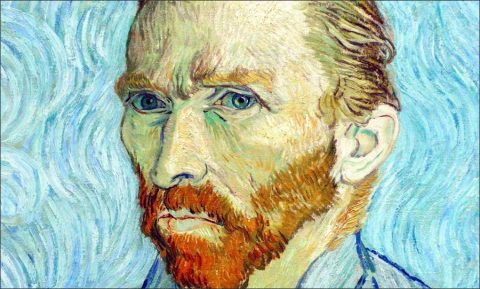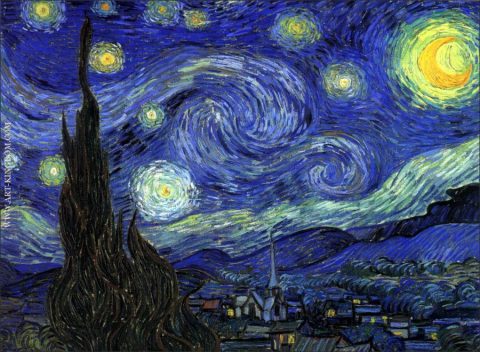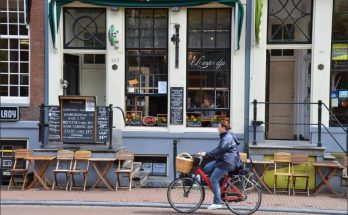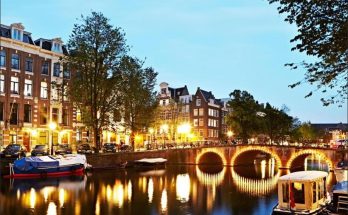No better example could be found of a life that became one long aspiration towards the light, a reaching for the stars, than Van Gogh’s. In everything he did, he strove to transcend human realities, to idealize man and hymn his greatness. Take, for instance, his evangelical mission among the miners of the Borinage: its failure was one of the worst blows he ever suffered and yet the motives that led him to devote himself to his fellow men as a preacher were to be the making of him as an artist.
Henceforth, he would continue his quest for God through the medium of his painting. He was not, however, the type of person who withdraws from the world and thinks of God as a kind of mathematical formula. His feet were on the ground, mired in the rich earth in which he was so often to stumble. As far as Van Gogh was concerned, the idealization of man–his painter’s way of approaching God–would be inextricably bound up with the misery of human existence.
In his works, the most dazzling constellation would always be glimpsed through a cloud of ashes and blood. Thus, through his Christianity, he came to be the herald of expressionism, or rather its prototype.
Van Gogh’s case is, however, far from simple, and, despite the exceptional nature of his genius, it would be a mistake to consider him as an isolated figure owing but little to his country of period. All his life he was to remain “Vincent the Dutchman.” In other words, by painting reality, often in its grossest and most commonplace aspects, fired by his inner passion, he carried on the art tradition of the Low Countries; and it was in this sense that he continually harked back to Rembrandt. And while he underwent transitory influences, seeking confirmation in painters such as Millet and Delacroix, he was always to preserve the specific qualities of Dutch painting and would never–in this he was no doubt unique-lose touch with his national tradition.
To show his place in that tradition, we have thought it best to quote some strikingly prophetic lines on Dutch art from Eugène Fromentin Masters of Past Time ( 1876), which still hold good for Van Gogh–who, in fact, had read and re-read them, and they no doubt helped him towards a better understanding of himself.
It was part of the destiny of Holland to be drawn to verisimilitude, to revert to it at some time or another, to live on and find her salvation in the portrait… Dutch painting, one very soon realizes, was not and could not be anything but the portrait of Holland, her outward image, faithful, exact, thorough, life-like, unadorned… The law of its style is to be sincere, its obligation to be truthful. Its first condition is to be familiar, natural, character-revealing; it stems from a concourse of moral qualities–naïveté, patient goodwill and uprightness… Every object, by virtue of the interest it offers, has to be examined in its form and drawn before it is painted… Everywhere we find the same drawing… it seems to spring from everyday observation…
If we look for Rembrandt’s ideal in the lofty world of forms, we realize that he saw in it only moral beauties and physical uglinesses… He is more natural than anyone, though not so close to nature, more familiar, though not so earthy, more vulgar and yet quite as noble, ugly in his types…
He had a mania for posing before a mirror and painting himself. . . but all alone, within a small compass, looking himself in the yes, intent on himself. Later, after his mature years, fallen on evil days, he comes forward… in dark apparel with a kerchief round his head, his face dispirited, wrinkled, emaciated, his palette in his rough hands.
“He had a mania for posing before a mirror and painting himself. . .” Like Rembrandt, Van Gogh sought to distinguish between the human and the godlike elements in men’s faces, typified by his own–only to find that these are inseparable.
1853 Birth of Vincent Willem Van Gogh, March 30, at the parsonage of Groot Zundert, a village in Dutch Brabant, near the Belgian frontier. Eldest son of Pastor Theodorus, who came of an ancient, much respected Calvinist family, amongst whom we find clergymen, sailors, business men and art lovers. Three of Vincent’s uncles were picture-dealers.
Vincent Van Gogh Timeline
1856 Eugène Boudin meets young Claude Monet at Le Havre and guides his early efforts.
1857 May 1: Birth of Theo, Vincent’s favorite brother, who is to be his moral and material stand-by to the end of his days.
1859 Monet and Pissarro meet in Paris. Birth of Seurat.
1860 Large-scale private exhibition in Paris of Modern Painting ( Delacroix, Corot, Courbet, Millet).
1861 Edouard Manet shows for the first time at the Salon, and meets Baudelaire. Paul Cézanne’s first stay in Paris.
1862 Monet, Renoir and Sisley meet in Paris at Gleyre’s studio. Degas paints his first horse races at Longchamp.
1863 Salon des Refusés. Sharp attacks on Manet. Death of Delacroix.
1864 Pissarro exhibits at the Salon, figuring as “Corot’s pupil.” Birth of Toulouse-Lautrec at Albi.
1865 Studies at the Provily boarding-school in the neighboring town of Zevenbergen until 1869.
1865 Manet exhibits “Olympia.”
1866 Renoir and Sisley paint together at Marlotte (Forest of Fontainebleau).
1867 Paris World’s Fair. Extreme severity of the Salon jury: all the Impressionists are rejected, except Degas. Death of Baudelaire and Ingres. Birth of Pierre Bonnard.
1869 July 30: Employed at the Goupil art-gallery at The Hague, then at Brussels. Reads much and visits museums.
1869 Renoir and Monet work at Bougival. The Impressionist technique takes form. Birth of Henri Matisse.
1870 Franco-Prussian War. Proclamation of the Third Republic.
1871 The Paris Commune. Birth of Georges Rouault.
1872 Begins exchanging letters with Theo.
1872 Degas’ trip to New Orleans.
1873 May: Transferred to Goupil’s London branch, while Theo enters the Brussels office.
June: Van Gogh proposes to the daughter of his landlady, Ursula Loyer, with whom he is wildly in love, but she rejects him. Bitter disappointment.
1873 Degas returns to France.
1874 Goes to Paris in October, returns to London in December.
1874 First Group Exhibition of the Impressionists (April 15-May 15); Cézanne is admitted only after difficulties, while Manet abstains.
1875 May: Van Gogh is transferred to headquarters in Paris. Quarrels with the Goupil staff and with customers. His obsession with the Bible begins.
1875 First impressionist sale at the H^tel Drouot. Death of Corot.
1876 April: Loses his job in Paris. Returns to England as a school-master at Ramsgate, then at Isleworth. Comes home to Etten for Christmas.
1876 Second Group Exhibition of the Impressionists (April). Gauguin is accepted at the official Salon; meets Pissarro and collects impressionist pictures.
1877 January 21-April 30: Clerk in a bookshop at Dordrecht. But Van Gogh is more and more obsessed by his religious vocation and, on May 9, goes to Amsterdam to study for admission to the theological college.
1877 Third Group Exhibition of the Impressionists (April). Cézanne paints at Pontoise with Pissarro, then at Auvers.
1878 July 22: Failing to pass the examination, Van Gogh gives up his studies and returns home. In August he begins a three-months’ course at an evangelical training-school at Brussels. On November 15 he is sent out as a lay preacher to the miners in the Borinage. Lodges with a pedlar at Les P^turages, a townlet near Mons. Shows immense zeal, nurses the sick, sleeps on bare boards.
1878 Paris World’s Fair. Duret publishes “Les Peintres impressionnistes.”
1879 January: Temporary pastor at Wasmes, in the heart of the black country, but relieved of his duties in July. Period of complete destitution, complete despair. August: Pastor Pietersen, an amateur watercolorist, buys two drawings from Van Gogh, who is now gradually getting free of his religious obsession.
1879 Fourth Group Exhibition of the Impressionists. Odilon Redon publishes “Dans le rêve,” a set of lithographs.
1880 January: Tramps the roads aimlessly. Stops at Courrières, intending to visit the painter Jules Breton, but dares not knock at his door. Summer: During these anxious months, the darkest of his life, Van Gogh glimpses his artistic vocation. Writes the long, emotional letter to his brother Theo in which he announces his decision to become a painter. Lives at Cuesmes, near Mons in the Borinage. Drawings of miners, copies after Millet. Brussels ( October 1880-April 1881): Lodges at a small hotel, 72, Bd. du Midi. Meets and makes friends with the painter Ridder van Rappard ( 1858-1892), with whom he corresponds for five years. Lessons in anatomy and perspective. First financial aid from Theo, who is now working for Goupil in Paris.
1880 Fifth Group Exhibition of the Impressionists (April); 18 participants, among them Gauguin.
1881 Etten (April-December): Lives with his parents. Conflicts with his father over his artistic career. Another ill-fated love-affair, with his cousin “K”. The Hague ( December 1881-September 1883). Cordially welcomed by his cousin, the painter Mauve, who gives him helpful advice.
1881 Birth of Picasso.
1882 January: Van Gogh picks up in the street a drunken–and pregnant–prostitute, Christine (whom he calls Sien), who serves him as model and companion for twenty months. March: Van Gogh quarrels with Mauve, who had nevertheless helped him considerably. June: A stay in hospital. Meets the painter Breitner. Given his first and only order, for 12 pen-and-ink sketches, views of the city. Takes walks to Scheveningen, Woorburg, Leidschendau. Watercolors, lithographs, studies of peasants and fishermen, seascapes, landscapes.
1882 July: He suffers from a feeling that others see in him a nonentity, a disagreeable crank; yet, he protests, “there is in me harmony, calm and music.” First oil paintings: the tones are somber, the impasto very thick.
1883 Drenthe (September-November): Stays at Hoogeveen, in a land of moors and peat-bogs. Studies of heath-land, thatched cottages, hamlets, peasants at work. December: Van Gogh returns to his parents at Nuenen, where his father has been appointed pastor. Sets up his studio in the vicarage barn. Works hard, reads Dickens, Carlyle, Beecher-Stowe.
1883 Death of Manet.
1884 August: Brief idyll with a local girl, Margot, who tries to commit suicide.
1884 Founding of the Salon des Indépendants by Seurat, Signac, Cross and Redon. Gauguin stays at Rouen, then moves to Copenhagen.
1885 March 27: Sudden death of Van Gogh’s father. He paints still lifes, peasants, weavers, studies of heads, “The Potato-Eaters” (April-May), “Head of an Old Peasant Woman” (June). “You won’t find any silvery tones in my present work, but only brown–bitumen, sepia and the like,” he writes in a letter to Theo. November 23: Leaves for Antwerp. Takes a studio at 194, Ruedes Images. Explores the city and harbor, and browses long in antique shops and book-stalls.
1885 Pissarro meets Theo van Gogh, then Signac and Seurat; adopts Pointillism in 1886. Gauguin returns to France in June, meets Degas at Dieppe in August.
1886 January: Discovers Rubens and Japanese prints. Enters the Academy and works under Sieber and Verlat, whose conformist outlook gets on his nerves. End of February: Van Gogh suddenly decides to go to Paris. March: Theo welcomes him enthusiastically and puts him up, first in the Rue Laval (now Rue Victor-Massé), then at 54, Rue Lepic. His eyes are opened to bright colors.
1886 June: Enters Cormon’s studio where he meets Toulouse-Lautrec. Haunts the Louvre.
1886 Eighth and last Group Exhibition of the Impressionists in Paris. Durand-Ruel organizes a large-scale Impressionist Exhibition in New York. Félix Fénéon publishes “Les Impressionnistes en 1886.” Gauguin’s first stay at Pont-Aven in Brittany, at the Pension Gloanec. Revelation of the Douanier Rousseau at the Indépendants. Rimbaud publishes his “Illuminations.”
1887 Influenced by the Impressionists. Often visits Père Tanguy’s shop and the Cabaret du Tambourin. Meets Pissarro, Degas, Seurat, Signac and Gauguin. Adopts the pointillist technique for a time. April: Van Gogh makes friends with Emile Bernard. June: Enthusiasm for the Japanese prints at the Bing Gallery. His palette grows brighter and his style is changing completely. More than 200 pictures date from this Paris period: self-portraits, still lifes, views of Montmartre and the suburbs, interiors. “The Restaurant” (summer 1887).
1887 Gauguin goes to Panama and Martinique with Charles Laval. Toulouse-Lautrec paints his first pictures of Montmartre life. Birth of Juan Gris and Marc Chagall. Mallarmé publishes his “Poésies complètes.”
1888 February 20: Leaves suddenly for Aries, on Lautrec’s advice. “It’s in the South that the studio of the future must be set up.” Arles ( February 1888-May 1889). February: Van Gogh puts up at the Restaurant Carrel. March: Plans an artists’ colony. Long exchange of letters with Theo. Death of Mauve. April: Spring landscapes: “Orchard in Bloom.” May: Moves to a small house, 2 Rue Lamartine, “a yellow house with a tiny white studio.” June: Stays for a week at Saintes-Maries-de-la-Mer. Enraptured by his first sight of the Mediterranean. Paints “Boats on the Beach.” July: Drawings of La Crau, near Montmajour. Pays a visit to his friend the Belgian poet Boch at Fontvieille. August: Becomes friendly with the local postman Roulin and his family, whose portraits he makes. Paints “Sunflowers.” September: Nightscapes and “Outdoor Café at Night.”
1888 Between October 20-25: Arrival of Gauguin, who has a great influence on him. Two months of life in common, during which the tension mounts between these two men of fiercely opposed natures. December: Van Gogh and Gauguin visit Montpellier together to see the works left to the museum by Bruyas. December 24: Van Gogh attempts to kill Gauguin, then cuts off his own ear. Gauguin hurries back to Paris. Theo arrives. Two weeks’ confinement in hospital.
1888 Gauguin’s first one-man show at Boussod and Valadon’s; his second stay at Pont-Aven; second and, this time, fruitful meeting with Emile Bernard. Beginnings of Cloisonnism and Synthesism. Bonnard, Vuillard, Maurice Denis, Ranson, Paul Sérusier meet at the Académie Julian. Cézanne makes a long stay in Paris. The Belgian painter James Ensor paints his large-scale work: “The Entrance of Christ into Brussels.”
1889 January 7: Van Gogh returns to his house. “Self Portrait with Cut Ear,” “Still Life with Onions,” “La Berceuse.” February: Hallucinations. Hostility of the neighbors. The police are called in, and he is confined again until the end of March. Signac visits him. April 17: Theo’s marriage. Van Gogh painted 200 pictures during this period, the most fruitful and important of his career. May 9: At his own request Van Gogh is admitted to the asylum at Saint-Rémy, a townlet near Arles. Dr Rey looks after him. Has two rooms at his disposal and comparative freedom. Long intervals of lucidity between spells of madness.
1889 Paris World’s Fair. Construction of the Eiffel Tower. Verlaine publishes “Parallèlement.” Gauguin’s third stay at. Pont-Aven, then at Le Pouldu, where he paints “The Yellow Christ.”
1890 January: Birth of Theo’s son, Vincent Willem. First article dealing with Van Gogh’s work: Albert Aurier’s enthusiastic appreciation in Le Mercure de France. March: One of his pictures, “The Red Vineyard,” is sold for 400 francs at the Brussels exhibition of “Les Vingt”; this was the only picture sold during his lifetime. May 16: Leaves for Paris to visit Theo.
1890 Van Gogh painted 150 pictures during this period of feverishly intense activity: among them “The Cypresses,” “The Hospital at Arles,” self-portraits and portraits of the asylum staff, “On the Edge of the Alpines,” as well as some thirty copies from Millet, Delacroix, Daumier, Rembrandt, Doré. May 21: Van Gogh arrives at Auvers. Becomes the patient and friend of Dr Gachet, whose portrait he paints. Puts up with Père Ravoux, Place de la Mairie. July 1: Spends several days in Paris, meets Lautrec again and Albert Aurier. Returns to Auvers and paints “three huge canvases, three far-flung wheatfields under lowering skies”; also, on July 14, “La Mairie d’Auvers.” July 27: In the evening, when in the open country, shoots himself. July 29: Death of Van Gogh, aged 37, with faithful Theo at his side. His last words were: “There’ll never be an end to human misery.”
Six months later, on January 25, 1891, Theo died. The brothers lie side by side in the little cemetery at Auvers.
1890 Munch’s first stay in Paris, sees pictures by Pissarro, Seurat, Lautrec and, at Theo van Goghs, works by Gauguin and Vincent van Gogh. Alfred Vallette launches Le Mercure de France. Bonnard, Vuillard, Denis and Lugné-Poe share a studio at 28 Place Pigalle, Montmartre. Gauguin makes a long stay at Le Pouldu with Séguin, Filiger and Meyer de Haan, returning to Paris in December.
1891 Van Gogh Retrospective Exhibition at the Salon des Indépendants. Death of Seurat. Auction sale of Gauguin’s pictures at the Hôtel Drouot. Gauguin leaves for Tahiti.
This summary has been drawn from the documentary material compiled by Mr Jean Leymarie for The History of Modern Painting (Skira, 1949- 1950).




